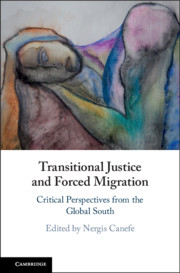Book contents
- Transitional Justice and Forced Migration
- Transitional Justice and Forced Migration
- Copyright page
- Dedication
- Contents
- Contributors
- Preface
- Acknowledgements
- Abbreviations
- In Lieu of an Introduction
- Part I The Past as the Memory of the Future
- Part II Law, Justice, and Hope
- Part III Ethics of Witnessing
- 8 Persecution, Prosecution, Protection
- 9 Transitional Justice, Reconciliation, and Reconstruction Process
- 10 The Principle of Legal Certainty
- 11 Perspectives on Legal Justice and Victim Reparations in the Diasporic African Great Lakes Region
- Index
- References
9 - Transitional Justice, Reconciliation, and Reconstruction Process
The Case of Former LTTE Female Combatants in Postwar Sri Lanka
from Part III - Ethics of Witnessing
Published online by Cambridge University Press: 24 October 2019
- Transitional Justice and Forced Migration
- Transitional Justice and Forced Migration
- Copyright page
- Dedication
- Contents
- Contributors
- Preface
- Acknowledgements
- Abbreviations
- In Lieu of an Introduction
- Part I The Past as the Memory of the Future
- Part II Law, Justice, and Hope
- Part III Ethics of Witnessing
- 8 Persecution, Prosecution, Protection
- 9 Transitional Justice, Reconciliation, and Reconstruction Process
- 10 The Principle of Legal Certainty
- 11 Perspectives on Legal Justice and Victim Reparations in the Diasporic African Great Lakes Region
- Index
- References
Summary
The present Sri Lankan state acclaims itself as a country that uprooted terrorism from its soil by defeating the LTTE in the civil war in May 2009. This victory and consequent “peace” came at a significant human cost of destruction, displacement and loss of lives. The chapter asserts that idea of transitional justice in Sri Lanka needs to be mooted, especially in conjunction with the ground realities of the Sri Lankan society and state. In this relation, the chapter proposes that transitional justice in the postwar Sri Lanka will be incomplete without looking into the aspect of political agency of former female “Liberation Tigers of Tamil Eelam” (Tamil Elam Vitutalaip Pulikal) combatants during the conflict.
Information
- Type
- Chapter
- Information
- Transitional Justice and Forced MigrationCritical Perspectives from the Global South, pp. 222 - 246Publisher: Cambridge University PressPrint publication year: 2019
